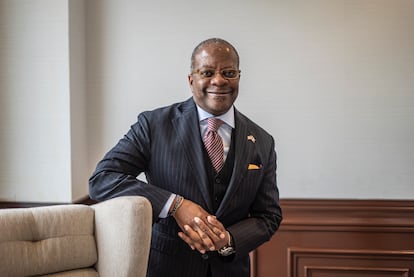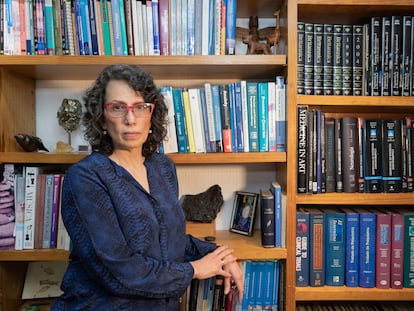Todd Robinson: ‘The United States and Mexico have shared responsibilities in the fight against fentanyl’
The assistant secretary of state for International Narcotics and Law Enforcement Affairs emphasizes that, in the face of the opioid crisis, the US will need to address drug trafficking as a matter of public health

Todd Robinson – assistant secretary for International Narcotics and Law Enforcement Affairs at the US State Department – is convinced that the growing demand for synthetic opioids, such as fentanyl, must be tackled at great speed in both Mexico and the United States.
Robinson affirms that his country is changing its approach to dealing with drug trafficking. Once perceived as a war, it is now a matter of public health. Every year, more than 100,000 Americans die from opioid use. The demand hasn’t stopped growing… and neither has the trafficking of narcotics between Mexico and the United States.
“Concentrated fentanyl is much more dangerous than cocaine or heroin. It’s easier to transport in smaller packages, so crossing the border is much easier,” he warns.
Before being in charge of the narcotics office at the State Department, Robinson, 60, a New Jersey native, had a long diplomatic career with a presence in various Latin American countries. For three years, he was the American ambassador to Guatemala (2014-2017) and was the acting ambassador to Venezuela until 2018, when Nicolás Maduro ordered his expulsion.
The diplomat attended the US-Mexico Synthetic Drug Conference held in Mexico City last week. There, he spoke with EL PAÍS about the US perspective on fentanyl trafficking.
Question: What expectations does the United States have for Mexico when it comes to drug trafficking, particularly fentanyl?
Answer: I like to talk about this in terms of shared responsibilities, because there are aspects of this problem on both sides of the border. We’re talking about the increase in overdose deaths [with synthetic opioids] in the United States over the last two years… [meanwhile], the problem in Mexico is the violence that surrounds the networks that are dedicated to the trafficking of these drugs, [as well as] the [illicit] money that strengthens these networks. Both countries have obligations and responsibilities to our citizens to do more to combat the trafficking of synthetic opioids.
Q. How will this be done?
A. We want to exchange more and better information. We want to make sure we know… who in Mexico and who in the United States is receiving these chemicals. We want to make sure that [the] chemicals – which largely come from China – have accurate labels that reflect what they really are and who they are for, so that we can get a better idea of what’s legal and what’s illegal. We need to get the healthcare industry involved and make sure we’re producing the necessary antidotes for potential overdoses. We want to make sure that our law enforcement partners have access to these antidotes [and that] both of our communities have access to treatment.
It’s very important to show how the US has changed its strategy on this issue. The fact that we have a doctor in charge of the Office of National Drug Control Policy is a clear sign that we’re looking at this from a different perspective. The first director of this office was a military general. We’ve gone from this idea that this is a war, to [the notion] that it’s much more important to focus on the public health sector.
Q. The DEA has recently insisted that it needs more cooperation from Mexico. What can Mexico do to break the drug supply chain?
A. Every country – including Mexico – needs to do a better job of sharing information, making sure they know where these chemicals are going and making sure that, throughout the transit operation, the chemicals are labeled correctly. We need to do a better job of targeting where the labs are, both in the United States and in other countries, including Mexico. We need to do more to secure our ports along the [supply] chain. We need more complex financial investigations, so that we can focus on the money side and make sure these criminal networks don’t have access to the international banking system.
Some aspects of the trafficking chain may focus on Mexico… but in reality, [this] is a global problem. Fentanyl is really taking a toll on America. We’re the warning sign. But once [our] market is saturated, these networks will look to traffic in other parts of the world.
Q. There is data from the United States Sentencing Commission that indicates that close to 80% of the people sentenced for smuggling fentanyl at the border are Americans. Who is trafficking this drug from Mexico to the US?
A. I haven’t seen those figures. What we do know is which networks are moving fentanyl in particular. We know that [these groups include] the Sinaloa Cartel and the Jalisco New Generation Cartel. Now, could some of [these traffickers] be Mexican-American citizens? It’s possible. We know that these organizations are based here in Mexico. So, it’s really a shared responsibility between our countries to focus on these two organizations in particular. [We need] to make it as difficult as possible for [these groups] to smuggle drugs north and weapons and money south. And that’s what we’re going to do.
Q. About the financing of these organizations: how are they using new technologies – such as cryptocurrencies and the blockchain – to move their money?
A. Something that adds complexity to the situation is the fact that digital currencies are being used by these networks to move their money. There are also other strategies that [the traffickers] are using... there are financial networks – based in the People’s Republic of China – which have very strong ties in Mexico and which are protecting Chinese companies that are involved in the trafficking of chemical precursors. We’re getting better at tracking those financial networks, but it’s not easy.
Q. Is Mexico up to the task of detecting these financial schemes?
A. Absolutely. Mexico has financial experts who are capable of doing complex investigations. Is there more we can do? Yes. Is more cooperation between our countries necessary? Absolutely. But I have no doubt that Mexican agencies can do this type of investigation.
Q. Studies have been conducted at the US-Mexico border to understand how fentanyl trafficking works. What are the conclusions that have most caught your attention?
A. We know that the same routes that are used for smuggling, weapons and people are also used for drug trafficking. We also know that networks that are involved in drug trafficking are using innovative ways to [move supplies] across the border, for example, with unmanned aerial vehicles (drones). [Fentanyl] can be moved in smaller packages, making it easier to hide it in private vehicles and trucks coming and going. And here’s the real problem: legal trade between the United States and Mexico is very important and very big. What we have to do is find a way to clear the paths for legal trade, but at the same time, close the paths for illicit trade. That’s part of what these studies looked at, to try to give us some ideas about how to make this happen.
Q. Are these drug cartels using migrants to smuggle fentanyl across the border?
A. Absolutely. Both the Sinaloa and CJNG cartels are expanding their illicit businesses to include human trafficking. Some of [these victims] are probably being used to move these drugs around. But we have to recognize that they aren’t using a single vehicle – they are using every possible vehicle to move these drugs, because it’s a very profitable business. Therein lies the responsibility of the United States: to make it less profitable for them, by focusing on the public health aspect.
Q. In recent weeks, President López Obrador has suggested the idea of prohibiting the use of fentanyl in the medical sector. What do you think of this?
A. I’m not a medical expert, so I can’t really speak to it. I’m sure there’s a reason [why] the medical community wants to continue using fentanyl. But I would say that because of the nature of the problem, it’s an honest discussion that needs to be taken up again. Because so many people have died and may die in the future. I don’t think any topic should be taken off the table.
Q. President López Obrador also insists on a narrative in which Mexico supposedly does not produce synthetic drugs.
A. With the information I have available, we have a very clear idea of who is behind this [trafficking] network, where they are and, to a large extent, how it works. The cooperation and collaboration that we’re receiving from our Mexican counterparts is essential to ensure that it becomes increasingly difficult for these networks to do what they do and take advantage of the illicit profits they’re making.
Q. Are you focusing mainly on Sinaloa?
A. We are focused on the Sinaloa Cartel, but also in the Ciudad Juárez area. That’s not to say that [fentanyl trafficking] isn’t happening elsewhere, but those are the networks we’re most concerned about right now.
Suscríbase aquí a la newsletter de EL PAÍS México y reciba todas las claves informativas de la actualidad de este país
Tu suscripción se está usando en otro dispositivo
¿Quieres añadir otro usuario a tu suscripción?
Si continúas leyendo en este dispositivo, no se podrá leer en el otro.
FlechaTu suscripción se está usando en otro dispositivo y solo puedes acceder a EL PAÍS desde un dispositivo a la vez.
Si quieres compartir tu cuenta, cambia tu suscripción a la modalidad Premium, así podrás añadir otro usuario. Cada uno accederá con su propia cuenta de email, lo que os permitirá personalizar vuestra experiencia en EL PAÍS.
¿Tienes una suscripción de empresa? Accede aquí para contratar más cuentas.
En el caso de no saber quién está usando tu cuenta, te recomendamos cambiar tu contraseña aquí.
Si decides continuar compartiendo tu cuenta, este mensaje se mostrará en tu dispositivo y en el de la otra persona que está usando tu cuenta de forma indefinida, afectando a tu experiencia de lectura. Puedes consultar aquí los términos y condiciones de la suscripción digital.
More information
Archived In
Últimas noticias
Most viewed
- Sinaloa Cartel war is taking its toll on Los Chapitos
- Oona Chaplin: ‘I told James Cameron that I was living in a treehouse and starting a permaculture project with a friend’
- Reinhard Genzel, Nobel laureate in physics: ‘One-minute videos will never give you the truth’
- Why the price of coffee has skyrocketed: from Brazilian plantations to specialty coffee houses
- Silver prices are going crazy: This is what’s fueling the rally










































